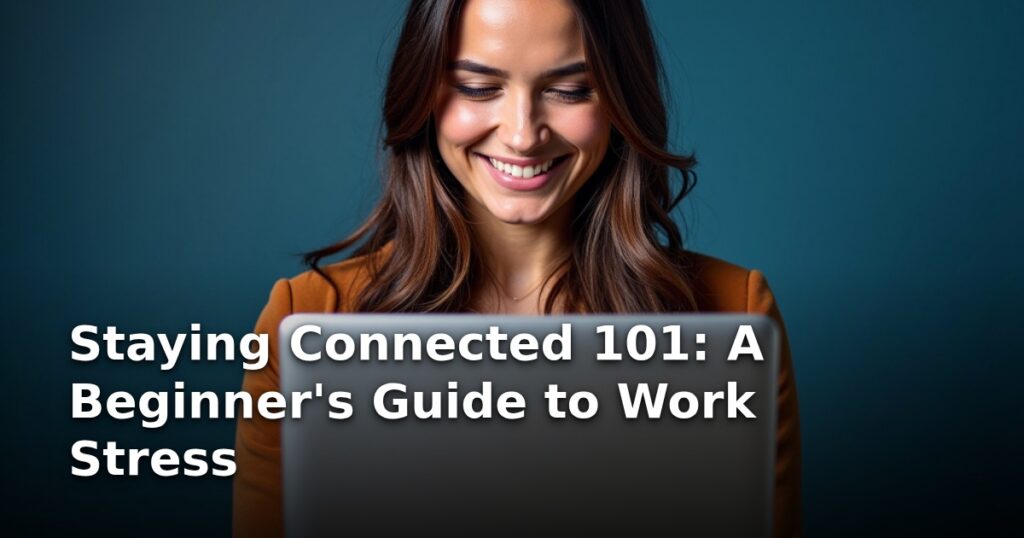Staying Connected 101: A Beginner's Guide to Work Stress
Welcome! If you've ever felt the weight of a demanding job starting to press on your personal life—your relationships, your peace of mind, or your overall well-being—then you've come to the right place. This guide is designed for absolute beginners who want to understand and start managing the common challenge of work stress before it takes over. We will explore practical, foundational strategies for staying connected during stressful work periods, ensuring your career success doesn't come at the expense of what matters most.
Understanding the Basics: What is Work Stress?
Work stress, in its simplest form, is the harmful physical and emotional responses that occur when the demands of your job do not match your capabilities, resources, or needs. Think of your energy like a battery. When you are happy, rested, and your job is manageable, your battery stays charged. Work stress happens when your job consistently drains that battery faster than you can recharge it.
This isn't just about feeling "busy." It’s a measurable physical reaction involving hormones like cortisol that, when prolonged, can lead to burnout, anxiety, and strain on personal relationships. Recognizing that what you are feeling is a normal response to high pressure is the first crucial step toward managing it effectively.
Why This Matters for Beginners: The Hidden Costs of Unmanaged Stress
Many beginners assume that high stress is just "part of the job" and that they need to tough it out. However, ignoring early signs of work stress has significant long-term costs. For those just starting out, learning these management techniques now builds a strong foundation for a sustainable career.

For example, chronic work stress often spills over into your home life. You might find yourself irritable or withdrawn, making effective communication in marriage or partnerships significantly harder. Furthermore, high stress can negatively impact romantic prospects; if you are single, you might be looking for dating advice for the new year focused on finding balance, but you need internal tools first. Learning to manage work stress protects your health, your relationships, and your future career longevity.
Essential Terminology Explained
To navigate this topic effectively, let’s define a few key concepts you will hear frequently:
- Burnout: This is not just being tired; it’s a state of emotional, physical, and mental exhaustion caused by excessive and prolonged stress. It often involves feelings of cynicism and reduced professional accomplishment.
- Work-Life Balance: This refers to the feeling of having appropriate prioritization between work and personal life. It’s not necessarily about spending equal time on both, but about feeling satisfied and present in both domains.
- Boundary Setting: This is the act of defining clear limits between your work time/space and your personal time/space. For instance, deciding you will not check work emails after 7 PM is setting a boundary.
- Self-Care: Simple, intentional activities you do to promote your physical, mental, and emotional health. This is essential for recharging that battery we mentioned earlier.
Getting Started: Your First Three Steps to Managing Work Stress
As a beginner, you don't need complex solutions; you need simple, actionable starting points. Here are three foundational steps you can implement immediately to begin staying connected during stressful work periods:
1. Conduct a Simple Stress Audit

You can't manage what you don't measure. For one week, keep a small log (digital or physical). Note down when you feel the most stressed during the workday. Is it during morning meetings? Late-night deadlines? Also, note when you feel least stressed. This awareness helps you pinpoint your pressure points, rather than feeling stressed all the time without knowing why.
2. Implement the "Hard Stop" Boundary
Choose one specific time each day that marks the absolute end of your workday (e.g., 5:30 PM). When that time hits, physically close your laptop, put your work phone in a drawer, and transition to a non-work activity, even if it’s just five minutes of stretching or making a cup of tea. This small ritual signals to your brain that the "work shift" is over.
3. Schedule Connection Time
If you are in a relationship, stress often causes couples to drift apart unintentionally. To combat this, proactively schedule non-negotiable time together. This could be a 15-minute "check-in" after work where you discuss anything except work, or planning a date night. If you are navigating complex family dynamics, this scheduled time is crucial for managing in-law relationship stress by ensuring your core partnership remains strong and supported.
Common Beginner Mistakes to Avoid
Even with the best intentions, newcomers often fall into traps that exacerbate stress rather than alleviate it. Be mindful of these common pitfalls:

- The "All or Nothing" Trap: Believing that if you can’t achieve perfect work-life balance instantly, you should give up. Small, consistent changes are far more effective than massive, unsustainable overhauls.
- Ignoring Relational Needs: When stressed, many people withdraw. While you might feel you need space, loved ones often interpret this withdrawal as rejection. This is where the need for holiday relationship advice often stems from—unaddressed stress during busy seasons leads to strained interactions. Make a conscious effort to offer brief reassurance, even when you are overwhelmed.
- Confusing Comfort with Coping: Reaching for highly convenient but unhealthy coping mechanisms (like excessive screen time, overeating, or avoiding difficult conversations) might feel good momentarily. True coping involves activities that genuinely replenish your resources, like exercise, hobbies, or honest conversation.
Next Steps for Continued Growth
Once you have established your initial boundaries and awareness, you can begin to deepen your practice. Consider these pathways for continued learning:
- Deepen Communication Skills: Invest time in learning active listening techniques. This is the cornerstone of effective communication in marriage and all close relationships, especially when discussing difficult topics like workload or personal needs.
- Explore Time Management Basics: Learning how to prioritize tasks (e.g., using the Eisenhower Matrix to distinguish between urgent and important tasks) can reduce the feeling of being perpetually behind, which is a major stress driver.
- Review Your Support System: If you are single and navigating the dating world, remember that being honest about your professional demands is vital. Good dating advice for the new year often centers on authenticity—don't hide your work intensity, but demonstrate how you actively manage it.
Conclusion: Building a Resilient Foundation
Navigating work stress is not about eliminating challenges; it’s about building the internal and external structures that allow you to meet those challenges without collapsing. By starting with simple awareness, setting clear boundaries, and proactively scheduling connection time, you are laying a resilient foundation for your career and your personal life. Remember, managing stress is a skill, and like any skill, it improves with consistent, patient practice. You have taken the first step today, and that is something to be proud of.



